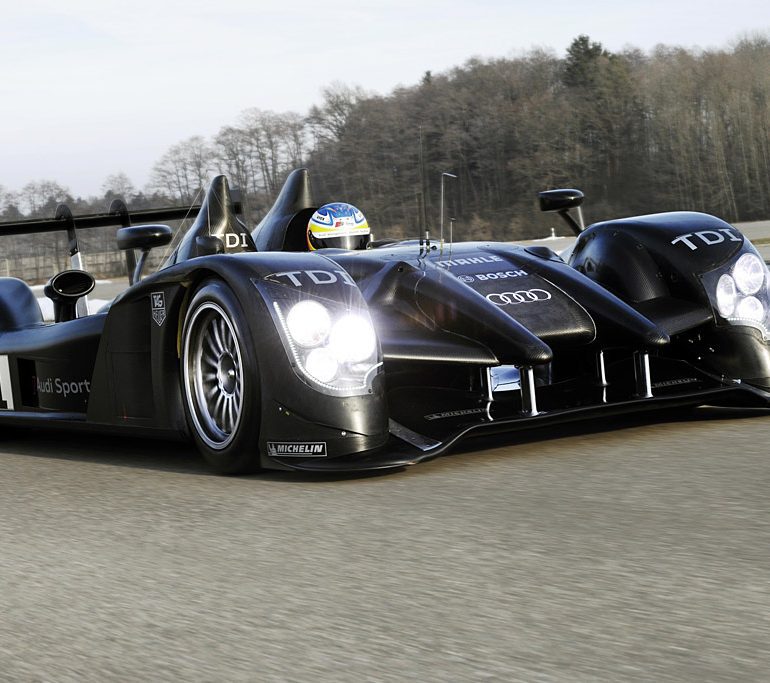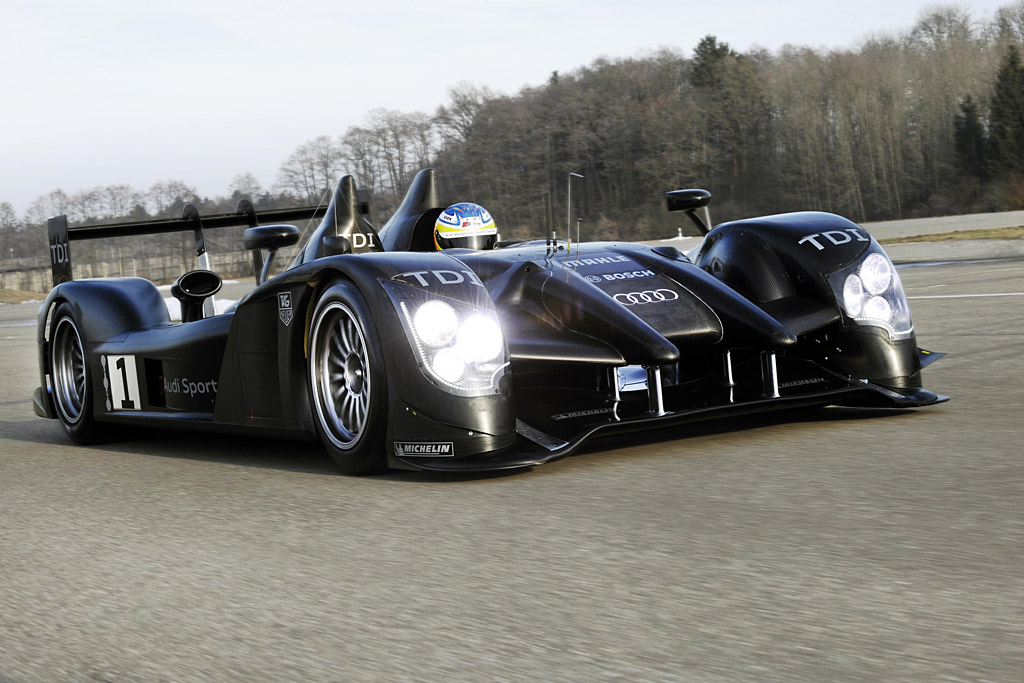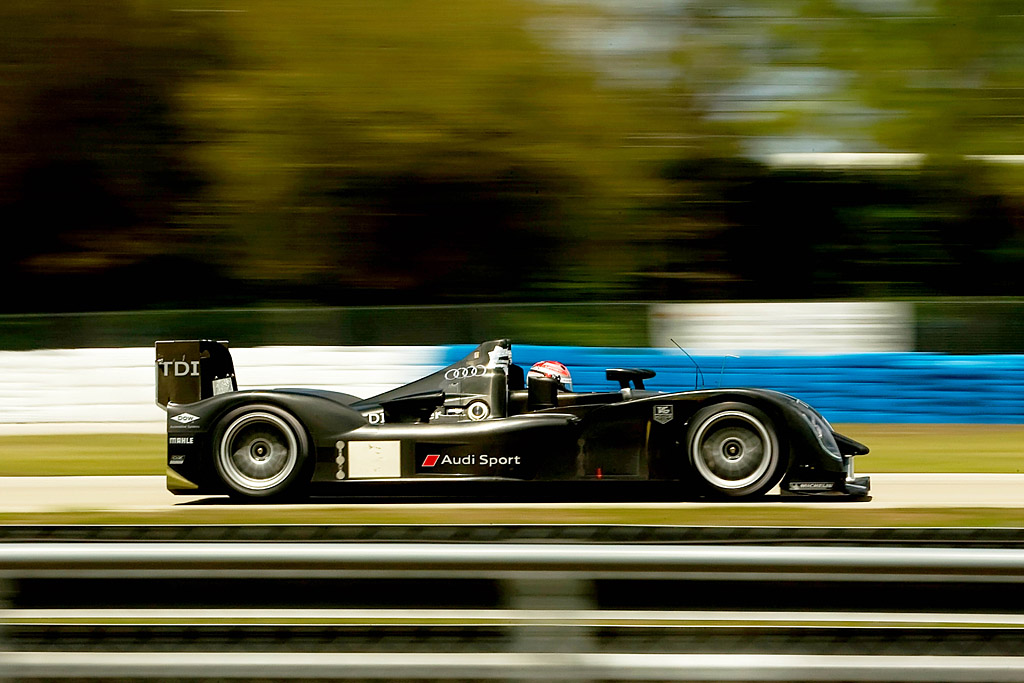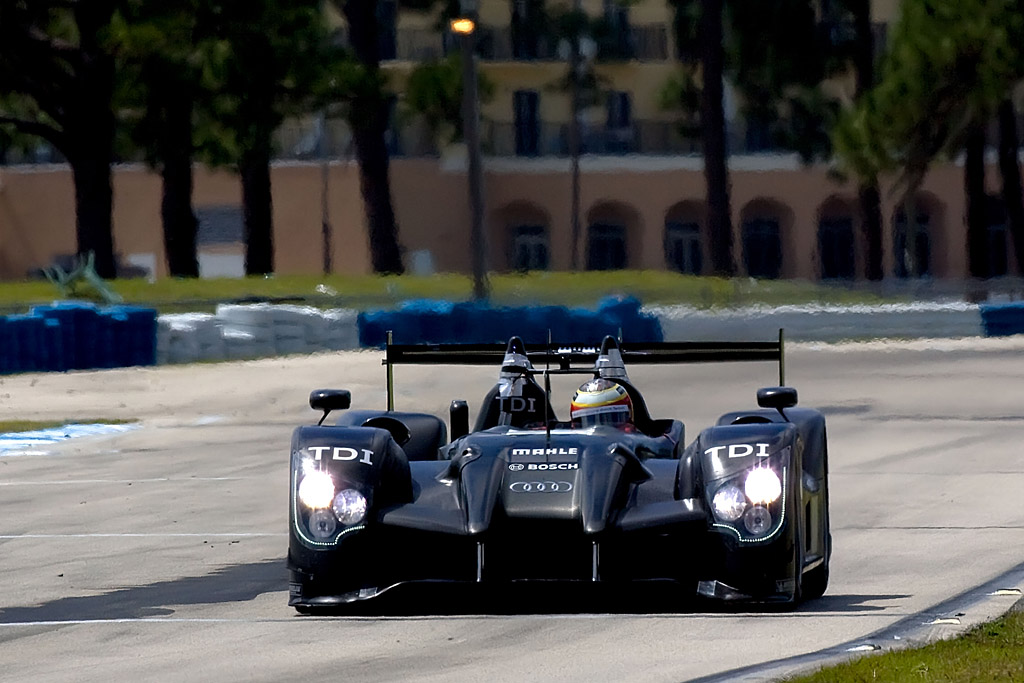2010 Audi R15 TDI plus
For the 2010 season, Audi have updated their R15 to win the 24 Hours of Le Mans under the banner of Audi Sport Team Joest and Audi Sport North America. Called the R15 plus or R15+, it is a modified version of the 2009 race car with new front aerodynamics that focus air through the car to reduce overall drag. Thus, the front end is completely different and is easily identified by its split nose.
These aerodynamic revisions were necessary since the flap that linked the front fenders was deemed an illegal aerodynamic device and needed to be replaced by a single-plane wing in 2010. Furthermore new regulations regarding the thickness of the splitter’s trailing edge reshaped the car and vortex generators were introduced to control flow separation.
Audi first raced the R15 at the 8 Hours of Castellet and won the event outright with only a single car. During the second round of the Le Mans series a full team of three cars was beaten by Peugeot as a prelude to Le Mans.
Press Release
Ingolstadt, March 15, 2010 – Audi will fight for victory in the Le Mans 24 Hours on June 12/13 with an evolution of the R15 TDI diesel race sports car. An extensive testing program with the revised LMP1 vehicle has just begun in the United States.
“From Audi’s perspective, the LMP1 is the better alternative to Formula 1 because this motorsport category features technologies and developments which are relevant to production vehicles,” explains Head of Audi Motorsport Dr. Wolfgang Ullrich. “At Le Mans, efficiency is of paramount importance – and today, more than ever before, it is a key deliverable of production vehicles as well and it is one of Audi’s special strengths.”
Therefore, efficiency was a focal point during the R15 TDI evolution project – particularly in the complex area of aerodynamics. “This year, the Le Mans regulations prescribe air restrictors with a smaller diameter and reduced supercharging pressure for diesel-powered vehicles,” says Dr. Martin Mühlmeier, Head of Technology at Audi Sport. “Due to the reduction of engine power as a result of the regulations we have tried to make the car’s aerodynamics even more efficient than before and to improve the Cd value and downforce parameters.”
A late change in regulations that was announced only in November made the work of the engineers more difficult and forced Audi to completely modify the front section of the R15 TDI. Consequently, the diesel race sports car that is internally designated as “R15 plus” now has a new, distinctive face featuring a split nose.
The entire shape of the R15 TDI’s body has been revised for maximum efficiency. The same is true for the modified cooling and fuel tank system. The V10 TDI engine has been optimized for the smaller air restrictors and reduced supercharging pressure. “Our objective was to keep power loss to a minimum despite the limitations imposed by the regulations,” explains Ulrich Baretzky, Head of Engine Technology at Audi Sport. “We managed to do that through a lot of detailed work.” The 5.5-liter power plant continues to deliver more than 440 kW.
“After Le Mans 2009, our specifications for the R15 plus listed about 20 key items,” says Dr. Martin Mühlmeier. “Efficiency and reliability were at the top of the list but we also looked at details like improved nighttime lighting of the track. We were able to meet this wish of the drivers with a new headlight concept.”
The evolution version of the Audi R15 TDI completed its roll out on the Audi test track at Neustadt (Germany) on March 3. The vehicle was subsequently flown to the United States for two weeks of in-depth testing. Before the race at Le Mans in June, Audi Sport Team Joest will complete an extensive testing program on various European race tracks and test races at the 8 Hours of Le Castellet (France) on April 11 and at the 1000-kilometer race at Spa-Francorchamps (Belgium) on May 9.
A new partner has now joined the project: the logo of the renowned watchmaker TAG Heuer will be featured on the Audi R15 TDI. Some of the brand’s fame stems from U.S. actor Steve McQueen wearing a TAG Heuer watch in the movie “Le Mans.”
Story by Audi Motorsport
In Detail
| type | Racing Car |
| released at | 2010 8 Hours of Castellet |
| built at | Germany |
| body stylist | Audi Sport |
| coachbuilder | Dallara |
| engine | Diesel V10 |
| position | Mid, Longitudinal |
| aspiration | Variable Turbine Geometry (VTG) Turbochargers |
| displacement | 5499 cc / 335.57 in³ |
| engine designer | Ulrich Baretzky |
| body / frame | Carbon Fibre & Aluminum Honeycomb Chassis |
| driven wheels | RWD |
| front tires | 33/68-18 Michelin |
| rear tires | 37/71-18 Michelin |
| front brakes | Brembro Carbon Ceramic Discs |
| rear brakes | Brembro Carbon Ceramic Discs |
| f suspension | Double Wishbones w/Pushrod-Actuated Inboard Torsion Bars |
| r suspension | Double Wishbones w/Pushrod-Actuated Inboard Torsion Bars |
| transmission | X-Trac 5-Speed Sequential |
| fuel capacity | 81 litres or 21.38 gal. |
| key drivers | Allan McNish, Dindo Capello, Tom Christensen |
| race victories | 2010 8 Hours of Castellet, 2010 24 Hours of Le Mans |







